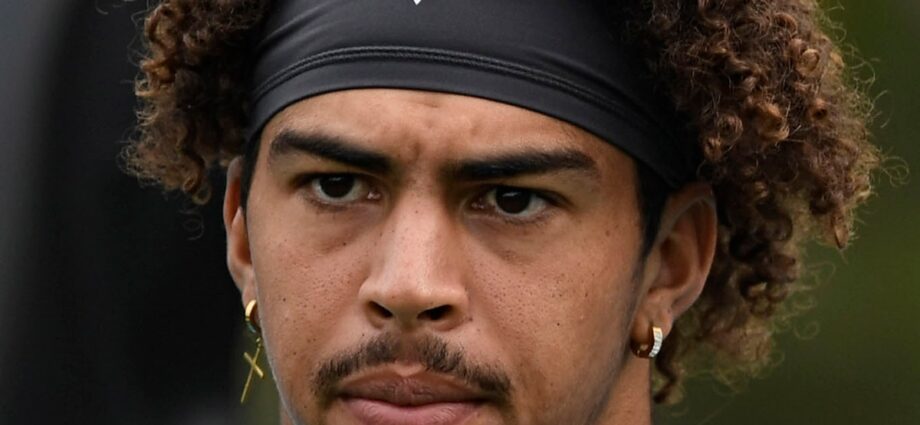 Barnwell explained.
Barnwell explained.
“It’s the second time the Vikings have paid Oliver, who joined the team on a three-year, $21 million deal two years ago. The numbers back up the idea that Oliver is an elite blocker. He ranked fourth among eligible tight ends in ESPN’s run block win rate a year ago, finishing just behind a former teammate in now-Jaguars tight end Johnny Mundt.”
Oliver has already spent two seasons in Minnesota, helping to improve the rushing offense from 27th in the league per DVOA before he arrived to 20th-best last season.
Barnwell added, “NFL Next Gen Stats credited Oliver with only two pressures allowed across 55 pass-blocking snaps, producing a pressure rate that was just about half the league average among tight ends.”
Barnwell on Oliver’s Value
There’s also the matter of value, which Barnwell mentioned, “Is that worth more than $7 million per year in a market where good blockers such as Mundt ($2.8 million) and Chris Manhertz ($1.4 million, Giants) are making way less? It’s tough to say. Oliver is just good enough of a receiver to give teams pause when he’s running routes up the seam and off play-action boot concepts.”
“Combine that with great blocking and he’s a very useful player, one who lined up on just about half of the offensive snaps for the Vikings in 2024. As teams lean further into 12 personnel groupings, Oliver and John Bates (Commanders) could end up as undervalued examples of an archetype seeing the field more than ever before.”
 T.J. Hockenson.
T.J. Hockenson.
A New Contract
Ten days ago, Minnesota locked in a three-year extension for Oliver, worth $23.5 million, a somewhat unforeseen agreement because some credible Minneapolis-based sources had said that Oliver was trending toward 2026 free agency.
He never made it, and now Minnesota has its ESPN-defined luxury asset in the saddle for four more seasons.
The Stats from 2024
Oliver, 28, recorded 22 receptions in 2024 for 258 receiving yards and 3 touchdowns.
That production is certainly not enough to pull down the lofty extension, but Barnwell is right — it’s the run blocking, the dirty work, that got Oliver paid.
 runs after the catch as Tampa Bay Buccaneers cornerback Jamel Dean (35) makes the tackle and linebacker Anthony Nelson (98) moves in to assist during the third quarter at U.S. Bank Stadium. Mandatory Credit: Jeffrey Becker-USA TODAY Sports.</p>
<p>” data-medium-file=”https://vikingsterritory.com/cdn-cgi/image/width=788,height=444,fit=crop,quality=80,format=auto,onerror=redirect,metadata=none/wp-content/uploads/2023/09/USATSI_21390933.jpg” data-large-file=”https://vikingsterritory.com/cdn-cgi/image/width=1180,height=787,fit=crop,quality=80,format=auto,onerror=redirect,metadata=none/wp-content/uploads/2023/09/USATSI_21390933.jpg” src=”https://vikingsterritory.com/cdn-cgi/image/width=788,height=444,fit=crop,quality=80,format=auto,onerror=redirect,metadata=none/wp-content/uploads/2023/09/USATSI_21390933.jpg” alt><figcaption>Sep 10, 2023; Minneapolis, MN, USA; Minnesota tight end J. Oliver (84) is tackled by Tampa Bay Buccaneers cornerback Jamel Dean (35) during the third quarter at U.S. Bank Stadium as linebacker Anthony Nelson (98) closes in. Mandatory Credit: Jeffrey Becker-USA TODAY Sports.<span></span></figcaption></figure>
</div>
<p>Oliver earned a 73.0 run-blocking grade from<em> </em><a href=) Pro Football Focus last season, making him the league’s very best tight end at his craft. George Kittle checked in second at 70.8.
Pro Football Focus last season, making him the league’s very best tight end at his craft. George Kittle checked in second at 70.8.
For context, Hockenson checked in at 47.6 per PFF’s run-blocking metric.
The Need to Fix the Rushing Offense
While Minnesota’s rushing offense improved in 2024 from the previous two campaigns, it must take the next step to align with other Super Bowl contenders.
Aaron Jones departed the Green Bay Packers in the 2024 offseason, and his presence on the depth chart — he played all 17 games — worked wonders, especially in the first two months of the season. Currently, after freshly extending Jones and Oliver, along with trading for Jordan Mason from the San Francisco 49ers, the Vikings must drag the rushing offense’s efficiency to new heights.
It helps that Oliver is connected to the franchise for four more years.
PPTSD on Josh Oliver
Our own Brevan Bane opined on Oliver and the Vikings’ rushing offense this week.
He wrote, “The Vikings’ offense (really just the passing offense) has been above league-average since Josh Oliver got here (not really thanks to him), although the rushing offense has been below league-average.”
“Minnesota obviously still has faith in Oliver to aid them in this with the roughly $1 million annual increase and extension for three years, as well as the extension of Aaron Jones and the acquisition of Jordan Mason. Focusing on TE1, the Vikings’ passing offense wasn’t noticeably different for better or worse when T.J. Hockenson came back from injury halfway through 2024, further justifying me scratching my head as to why the Vikings are so eager to throw money at the tight end position.”



Dustin Baker is a political scientist who graduated from the University of Minnesota in 2007. Subscribe to his daily … More about Dustin Baker

